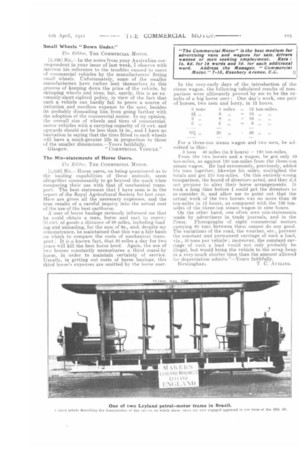Small Wheels " Down Under."
Page 17

If you've noticed an error in this article please click here to report it so we can fix it.
The Etlifor, THE COMMERCIAL MOTOR.
[1.339i Sir,—In the notes from your Australian correspoudent in your issue of last week, I observe with interest his reference to the troubles caused to users of commercial vehicles by the manufacturers fitting small wheels. Unfortunately, some of the smaller inanufacturers have rather lent themselves to this process of keeping down the price of the vehicle, by skimping wheels and tires, but, surely, this is an extremely-shortsighted policy, in view of the fact that such a vehicle can hardly fail to prove a source of irritation and needless expense to the user, besides its probably dissuading him from going further with the adoption of the commercial motor. In my opinion, the overall size or wheels and tires of commercialmotor vehicles with a carrying capacity of 15 cwt, and upwards should not be less than 34 in., and I have no hesitation in saying that the tires fitted to such wheels will have a much-greater life in proportion to those of the smaller dimensions.—Yours faithfully,
Glasgow. "COMMERCIAL VEHICLE."
The Mis-statements of Horse Users.
'17!c, Editor, THE COMMERCIAL MOTOR.
[1,340] Sir,—Horse users, on being questioned as to the hauling capabilities of these animals, seem altogether unnecessarily to go beyond the mark when comparing their use with that of mechanical transport. The best statement that I have seen is in the report of the Royal Agricultural Society for last year. Here are given all the necessary expenses, and the true results of a careful inquiry into the actual cost of the use of the best carthorse.
A user of horse haulage seriously informed me that he could obtain a man, horse and cart to convey 30 cwt. of goods a distance of in miles, including load. ing and unloading, for the sum of 9s., and, despite my remonstrance, he maintained that this was a fair basis on which to compare the costs of mechanical transport: It is a known fact, that 20 miles a day for two years will kill the best horse bred. Again, the use of Iwo horses constantly necessitates a third stand-by horse, in order to maintain certainty of service. Usually, in getting; out costs of horse haulage, this third horse's expenses are omitted by the horse user.
In the very-early days of the introduction of the steam wagon, the following tabulated results of comparison were ultimately proved by me to be the results of a big horse user : One day's work, one pair of horses, two men and lorry, in 12 hours.
For a three-ton steam wagon and two men, he admitted to this: 3 tons 40 miles (in 9 hours) 120 ton-miles.
From the two horses and a wagon, he got only 19 ton-miles, as against. 120 ton-miles from tile three-ton steam wagon. He had erroneously, previously, added his tons together, likewise his miles, multiplied the totals and got 210 ton-miles. On this entirely-wrong; 'comparison, the board of directors acted, and they did not propose to alter their horse arrangements. It took a long time before I could get the directors to. re-consider it, and allow me to point out that the actual work of the two horses was no more than 49 ton-miles in 12 hours, as compared with the 120 tonmiles of the three-ton steam wagon in nine hours.
On the other hand, one often sees mis-statements made by advertisers in trade journals, and in the Press. Photographs of eight commercial motors carrying 80 tons between them cannot do any good. The variations of the road, the weather, etc., prevent the constant and permanent carriage of such a load, viz., 10 tons per vehicle ; moreover, the constant carriage of such a load would not only probably be illegal, but would bring the vehicle to the scrap heap in a very-much shorter time than the amount allowed For depreciation admits."--Yours faithfully,
Birmingham. T. C. AvaLING.




















